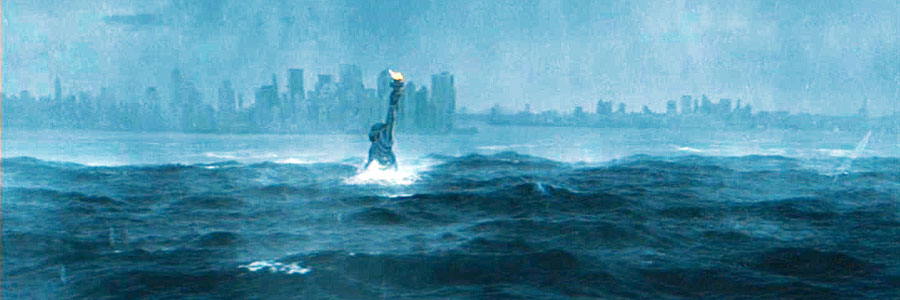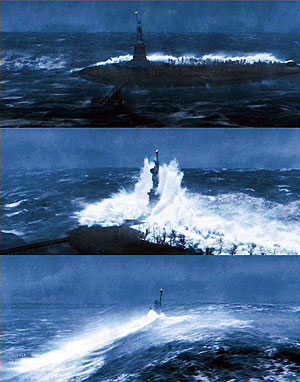
The Day After Tomorrow
20th Century Fox
Original release: May 28th, 2004
Running time: 118 minutes
Director: Roland Emmerich
Writers: Roland Emmerich, Jeffrey Nachmanoff
Cast: Dennis Quaid, Jake Gyllenhaal
New York 00:46:10 to 00:49:10
Deconstructing Cinema: One Scene At A Time, the complete series so far

20 years ago when they talked about the ozone layer, the danger of using aerosols and that rising sea levels may result in a significant change in the lives of people living in low lying coastal areas, many of us laughed it off and carried on as before. The idea of global warming and the so-called “greenhouse effect” was something that was more at home in science fiction movies and novels, and not something for us, our governments and politicians to take seriously. Today many us of are probably asking why didn’t we listen back then. The signs are all too clear now; our planet is changing. Our climates are becoming more unstable and over time we’re likely to experience more superstorms like Hurricane Sandy, the largest Atlantic hurricane on record, which battered the Caribbean, Mid-Atlantic and Northeastern United States in late October this year.
The Day After Tomorrow, a 2004 science fiction disaster film directed by Roland Emmerich, which took inspiration from The Coming Global Superstorm written by Art Bell and Whitley Strieber, was one of the most interesting films Hollywood released in the first few years following 9/11. Unlike other disaster films like The Core (2003), the events depicted in this film is something we can see happening today, although not on such a rapid scale that leads us into a new ice age.
Its story’s centred on Jack Hall (Dennis Quaid), a paleoclimatologist who presents his research and findings on global warming at a United Nations conference.
Jack’s presentation doesn’t go down well. His audience remain sceptical and for the most part confused as to how global warming could lead to global cooling.

Jack predicts this won’t happen for at least another 100 or even 1000 years, but what he doesn’t know yet is that the huge ice sheet which fell away in Antarctica at the start of the film has already begun to trigger this cooling event. With so much freshwater being dumped into the North Atlantic because of melting polar ice, desalinization is inevitable. When this happens, the current is disrupted.
Once they realise this has been happening, Jack is then asked to build a forecast model with his team based on his previous weather model that showed how climate changes caused the first Ice Age. From here we see Tokyo battered by hail stones the size of pumpkins, the mass migration of birds across the Northeastern United States, crippling blizzards in England and multiple tornadoes tearing through Los Angeles and wiping out the Hollywood sign. Yet the most devastating effects are yet to come. With the currents changing as a result of the freshwater and rise in sea level, a giant tidal wave is brewing and heading straight for New York.
It’s a breathtaking moment, one which audiences might not have been fully ready for in the years after 9/11 as New York takes another pounding, this time from the forces of nature. Shot in blue hues we see the waves crashing against Liberty Island and eventually engulfing the Statue of Liberty almost entirely. As the ocean swells, the sky darkens and streaks of lightning tear across it. For anyone who suffers from aquaphobia it’s a nerve shredding scene as the action shifts to the New York Public Library where Jack’s son Sam (Jake Gyllenhaal) and his friends are about to take refuge before the tidal wave reaches them.
It’s not the first time New York’s been devastated on screen. In the 90s we saw Independence Day (1996) and Armageddon both leaving the city in ruins (1998) while Deep Impact (1998) showed a 1000 foot tidal wave that flooded the area but left the Twin Towers still standing. It’s a similar watery sequence with The Day After Tomorrow but the footage from both films could be compared side by side and will show one thing missing – the World Trade Center complex. It’s a clear sign that the world the characters in The Day After Tomorrow inhabit is quite a different one from the world depicted in pre-9/11 films, but it’s also one where global warming becomes a frightening reality.
- [1] What does Obama’s victory mean for action on global warming? Damian Carrington, The Guardian [accessed November 9th, 2012]
- [2] Sidney Perkowitz Hollywood Science: Movies, Science, and the End of the World (2008), Columbia University Press
In the wake of hurricanes like Katrina and Sandy, two of the costliest Atlantic hurricanes in history, we can already see the evidence of the climate destabilising. As a result of Sandy particularly, global warming has now finally become a serious talking point among politicians and many are asking the same question; what does a second term for Barack Obama mean for action on climate change? ¹
The Day After Tomorrow, despite its clichéd story of a father desperate to rescue his son, and all the other sub-plots running through it, remains a significant film because of the way it illustrated “the conflict that can and does occur when scientific findings clash with government policies or political agendas”. ²

Patrick Samuel
The founder of Static Mass Emporium and one of its Editors in Chief is an emerging artist with a philosophy degree, working primarily with pastels and graphite pencils, but he also enjoys experimenting with water colours, acrylics, glass and oil paints.
Being on the autistic spectrum with Asperger’s Syndrome, he is stimulated by bold, contrasting colours, intricate details, multiple textures, and varying shades of light and dark. Patrick's work extends to sound and video, and when not drawing or painting, he can be found working on projects he shares online with his followers.
Patrick returned to drawing and painting after a prolonged break in December 2016 as part of his daily art therapy, and is now making the transition to being a full-time artist. As a spokesperson for autism awareness, he also gives talks and presentations on the benefits of creative therapy.
Static Mass is where he lives his passion for film and writing about it. A fan of film classics, documentaries and science fiction, Patrick prefers films with an impeccable way of storytelling that reflect on the human condition.
© 2022 STATIC MASS EMPORIUM . All Rights Reserved. Powered by METATEMPUS | creative.timeless.personal. | DISCLAIMER, TERMS & CONDITIONS
HOME | ABOUT | CONTACT | TWITTER | GOOGLE+ | FACEBOOK | TUMBLR | YOUTUBE | RSS FEED
CINEMA REVIEWS | BLU-RAY & DVD | THE EMPORIUM | DOCUMENTARIES | WORLD CINEMA | CULT MOVIES | INDIAN CINEMA | EARLY CINEMA
MOVIE CLASSICS | DECONSTRUCTING CINEMA | SOUNDTRACKS | INTERVIEWS | THE DIRECTOR’S CHAIR | JAPANESE CINEMA





